Interconnectedness of Agricultural Chemicals: ENV0002 Report, Impacts
VerifiedAdded on 2022/10/17
|10
|1801
|14
Report
AI Summary
This research paper meticulously explores the intricate interconnectedness of agricultural chemicals, including nematicides, molluscicides, fungicides, insecticides, fertilizers, and pesticides, and their far-reaching impacts on human life, water resources, biodiversity, and the surrounding land. The paper details how these chemicals disrupt soil chemistry and microbial activity, leading to soil degradation and reduced fertility. It also highlights the diverse ways humans are exposed to these chemicals, resulting in health issues ranging from minor skin irritations to severe conditions such as endocrine disruption, genetic changes, and even death. The research further examines the effects on biodiversity, including the destruction of wildlife habitats and the contamination of water sources, which can be highly lethal to aquatic life. The paper concludes with recommendations for mitigating these impacts, such as adopting biological pest control methods and permaculture practices, to promote sustainable agricultural practices and protect the environment.
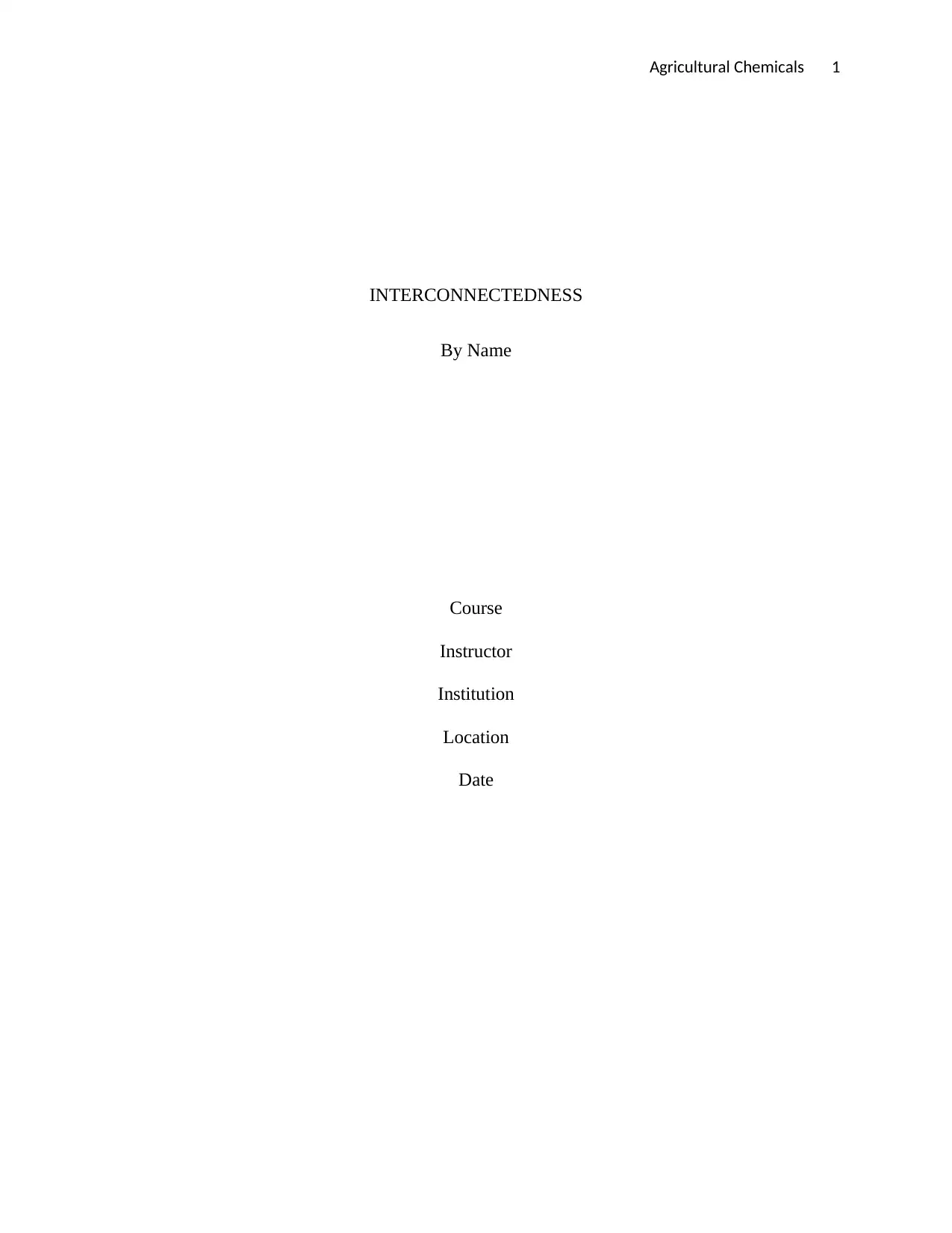
Agricultural Chemicals 1
INTERCONNECTEDNESS
By Name
Course
Instructor
Institution
Location
Date
INTERCONNECTEDNESS
By Name
Course
Instructor
Institution
Location
Date
Paraphrase This Document
Need a fresh take? Get an instant paraphrase of this document with our AI Paraphraser
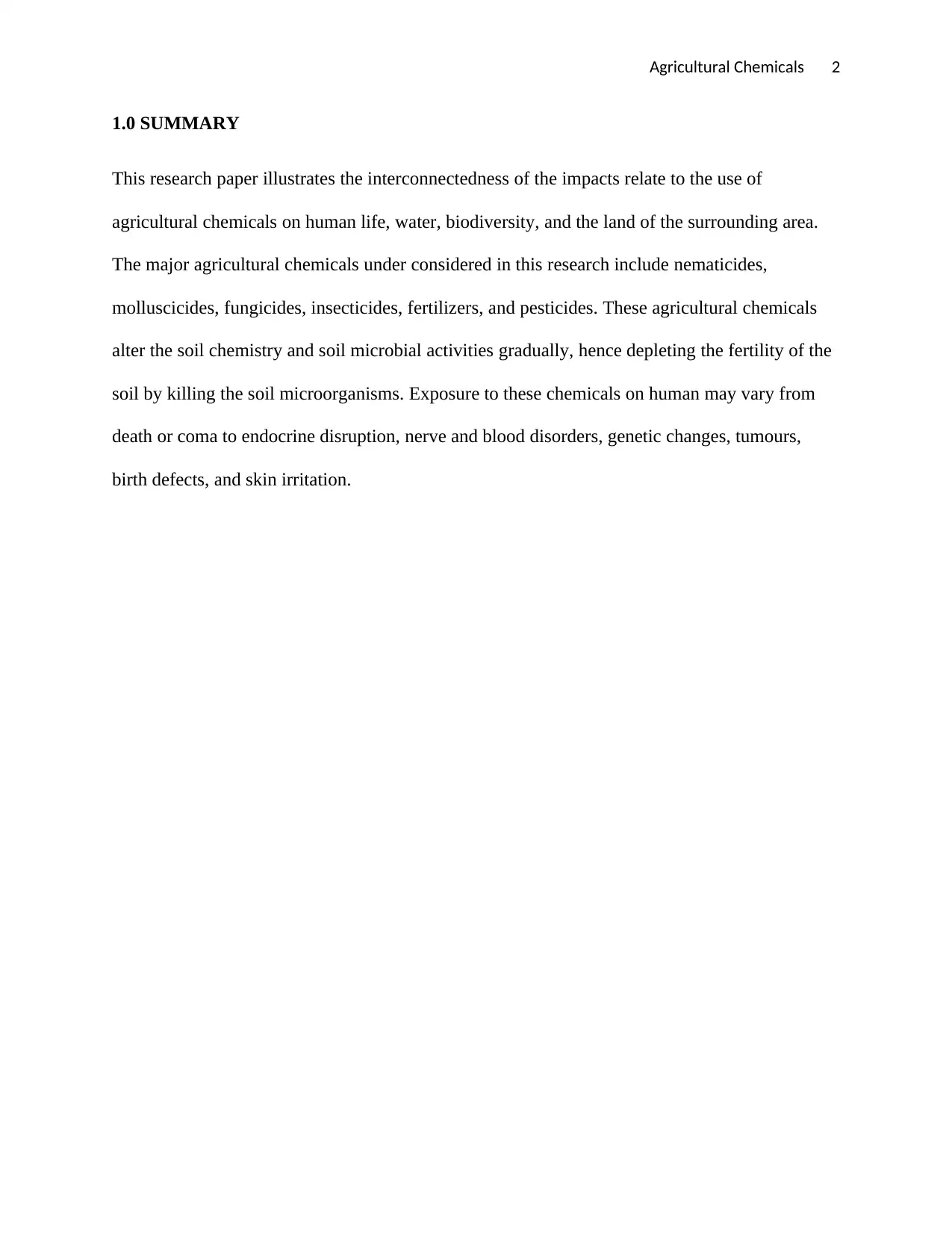
Agricultural Chemicals 2
1.0 SUMMARY
This research paper illustrates the interconnectedness of the impacts relate to the use of
agricultural chemicals on human life, water, biodiversity, and the land of the surrounding area.
The major agricultural chemicals under considered in this research include nematicides,
molluscicides, fungicides, insecticides, fertilizers, and pesticides. These agricultural chemicals
alter the soil chemistry and soil microbial activities gradually, hence depleting the fertility of the
soil by killing the soil microorganisms. Exposure to these chemicals on human may vary from
death or coma to endocrine disruption, nerve and blood disorders, genetic changes, tumours,
birth defects, and skin irritation.
1.0 SUMMARY
This research paper illustrates the interconnectedness of the impacts relate to the use of
agricultural chemicals on human life, water, biodiversity, and the land of the surrounding area.
The major agricultural chemicals under considered in this research include nematicides,
molluscicides, fungicides, insecticides, fertilizers, and pesticides. These agricultural chemicals
alter the soil chemistry and soil microbial activities gradually, hence depleting the fertility of the
soil by killing the soil microorganisms. Exposure to these chemicals on human may vary from
death or coma to endocrine disruption, nerve and blood disorders, genetic changes, tumours,
birth defects, and skin irritation.
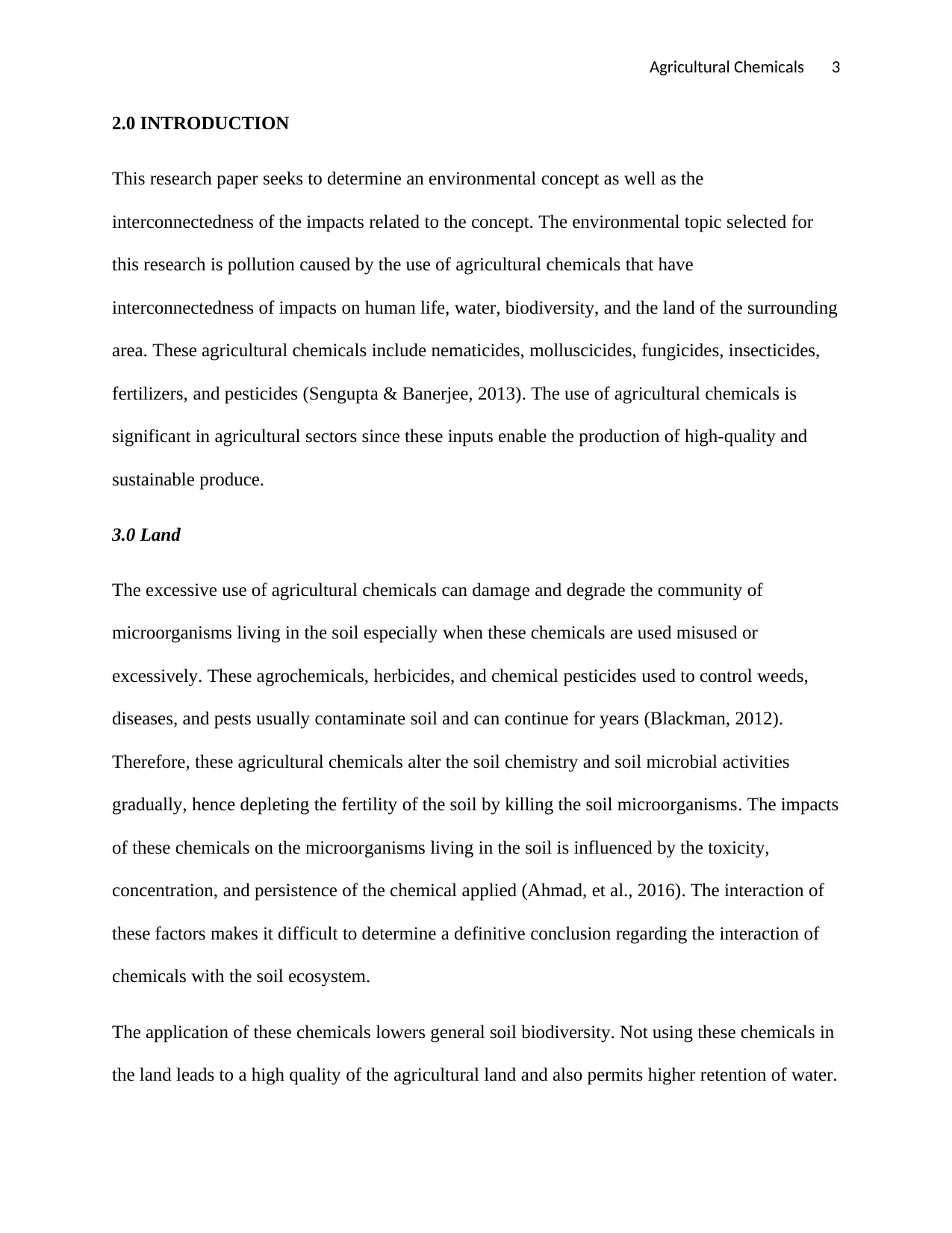
Agricultural Chemicals 3
2.0 INTRODUCTION
This research paper seeks to determine an environmental concept as well as the
interconnectedness of the impacts related to the concept. The environmental topic selected for
this research is pollution caused by the use of agricultural chemicals that have
interconnectedness of impacts on human life, water, biodiversity, and the land of the surrounding
area. These agricultural chemicals include nematicides, molluscicides, fungicides, insecticides,
fertilizers, and pesticides (Sengupta & Banerjee, 2013). The use of agricultural chemicals is
significant in agricultural sectors since these inputs enable the production of high-quality and
sustainable produce.
3.0 Land
The excessive use of agricultural chemicals can damage and degrade the community of
microorganisms living in the soil especially when these chemicals are used misused or
excessively. These agrochemicals, herbicides, and chemical pesticides used to control weeds,
diseases, and pests usually contaminate soil and can continue for years (Blackman, 2012).
Therefore, these agricultural chemicals alter the soil chemistry and soil microbial activities
gradually, hence depleting the fertility of the soil by killing the soil microorganisms. The impacts
of these chemicals on the microorganisms living in the soil is influenced by the toxicity,
concentration, and persistence of the chemical applied (Ahmad, et al., 2016). The interaction of
these factors makes it difficult to determine a definitive conclusion regarding the interaction of
chemicals with the soil ecosystem.
The application of these chemicals lowers general soil biodiversity. Not using these chemicals in
the land leads to a high quality of the agricultural land and also permits higher retention of water.
2.0 INTRODUCTION
This research paper seeks to determine an environmental concept as well as the
interconnectedness of the impacts related to the concept. The environmental topic selected for
this research is pollution caused by the use of agricultural chemicals that have
interconnectedness of impacts on human life, water, biodiversity, and the land of the surrounding
area. These agricultural chemicals include nematicides, molluscicides, fungicides, insecticides,
fertilizers, and pesticides (Sengupta & Banerjee, 2013). The use of agricultural chemicals is
significant in agricultural sectors since these inputs enable the production of high-quality and
sustainable produce.
3.0 Land
The excessive use of agricultural chemicals can damage and degrade the community of
microorganisms living in the soil especially when these chemicals are used misused or
excessively. These agrochemicals, herbicides, and chemical pesticides used to control weeds,
diseases, and pests usually contaminate soil and can continue for years (Blackman, 2012).
Therefore, these agricultural chemicals alter the soil chemistry and soil microbial activities
gradually, hence depleting the fertility of the soil by killing the soil microorganisms. The impacts
of these chemicals on the microorganisms living in the soil is influenced by the toxicity,
concentration, and persistence of the chemical applied (Ahmad, et al., 2016). The interaction of
these factors makes it difficult to determine a definitive conclusion regarding the interaction of
chemicals with the soil ecosystem.
The application of these chemicals lowers general soil biodiversity. Not using these chemicals in
the land leads to a high quality of the agricultural land and also permits higher retention of water.
⊘ This is a preview!⊘
Do you want full access?
Subscribe today to unlock all pages.

Trusted by 1+ million students worldwide
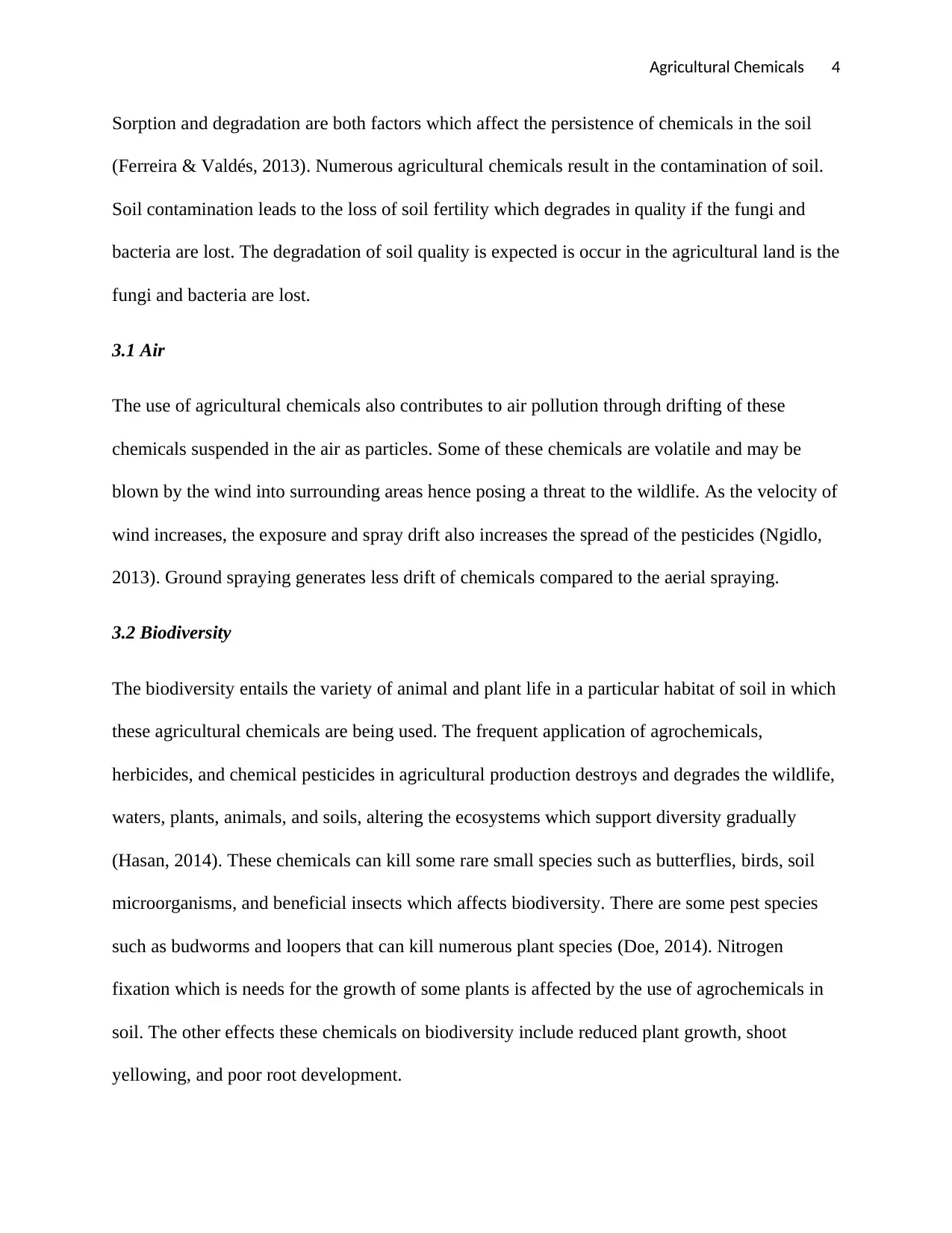
Agricultural Chemicals 4
Sorption and degradation are both factors which affect the persistence of chemicals in the soil
(Ferreira & Valdés, 2013). Numerous agricultural chemicals result in the contamination of soil.
Soil contamination leads to the loss of soil fertility which degrades in quality if the fungi and
bacteria are lost. The degradation of soil quality is expected is occur in the agricultural land is the
fungi and bacteria are lost.
3.1 Air
The use of agricultural chemicals also contributes to air pollution through drifting of these
chemicals suspended in the air as particles. Some of these chemicals are volatile and may be
blown by the wind into surrounding areas hence posing a threat to the wildlife. As the velocity of
wind increases, the exposure and spray drift also increases the spread of the pesticides (Ngidlo,
2013). Ground spraying generates less drift of chemicals compared to the aerial spraying.
3.2 Biodiversity
The biodiversity entails the variety of animal and plant life in a particular habitat of soil in which
these agricultural chemicals are being used. The frequent application of agrochemicals,
herbicides, and chemical pesticides in agricultural production destroys and degrades the wildlife,
waters, plants, animals, and soils, altering the ecosystems which support diversity gradually
(Hasan, 2014). These chemicals can kill some rare small species such as butterflies, birds, soil
microorganisms, and beneficial insects which affects biodiversity. There are some pest species
such as budworms and loopers that can kill numerous plant species (Doe, 2014). Nitrogen
fixation which is needs for the growth of some plants is affected by the use of agrochemicals in
soil. The other effects these chemicals on biodiversity include reduced plant growth, shoot
yellowing, and poor root development.
Sorption and degradation are both factors which affect the persistence of chemicals in the soil
(Ferreira & Valdés, 2013). Numerous agricultural chemicals result in the contamination of soil.
Soil contamination leads to the loss of soil fertility which degrades in quality if the fungi and
bacteria are lost. The degradation of soil quality is expected is occur in the agricultural land is the
fungi and bacteria are lost.
3.1 Air
The use of agricultural chemicals also contributes to air pollution through drifting of these
chemicals suspended in the air as particles. Some of these chemicals are volatile and may be
blown by the wind into surrounding areas hence posing a threat to the wildlife. As the velocity of
wind increases, the exposure and spray drift also increases the spread of the pesticides (Ngidlo,
2013). Ground spraying generates less drift of chemicals compared to the aerial spraying.
3.2 Biodiversity
The biodiversity entails the variety of animal and plant life in a particular habitat of soil in which
these agricultural chemicals are being used. The frequent application of agrochemicals,
herbicides, and chemical pesticides in agricultural production destroys and degrades the wildlife,
waters, plants, animals, and soils, altering the ecosystems which support diversity gradually
(Hasan, 2014). These chemicals can kill some rare small species such as butterflies, birds, soil
microorganisms, and beneficial insects which affects biodiversity. There are some pest species
such as budworms and loopers that can kill numerous plant species (Doe, 2014). Nitrogen
fixation which is needs for the growth of some plants is affected by the use of agrochemicals in
soil. The other effects these chemicals on biodiversity include reduced plant growth, shoot
yellowing, and poor root development.
Paraphrase This Document
Need a fresh take? Get an instant paraphrase of this document with our AI Paraphraser
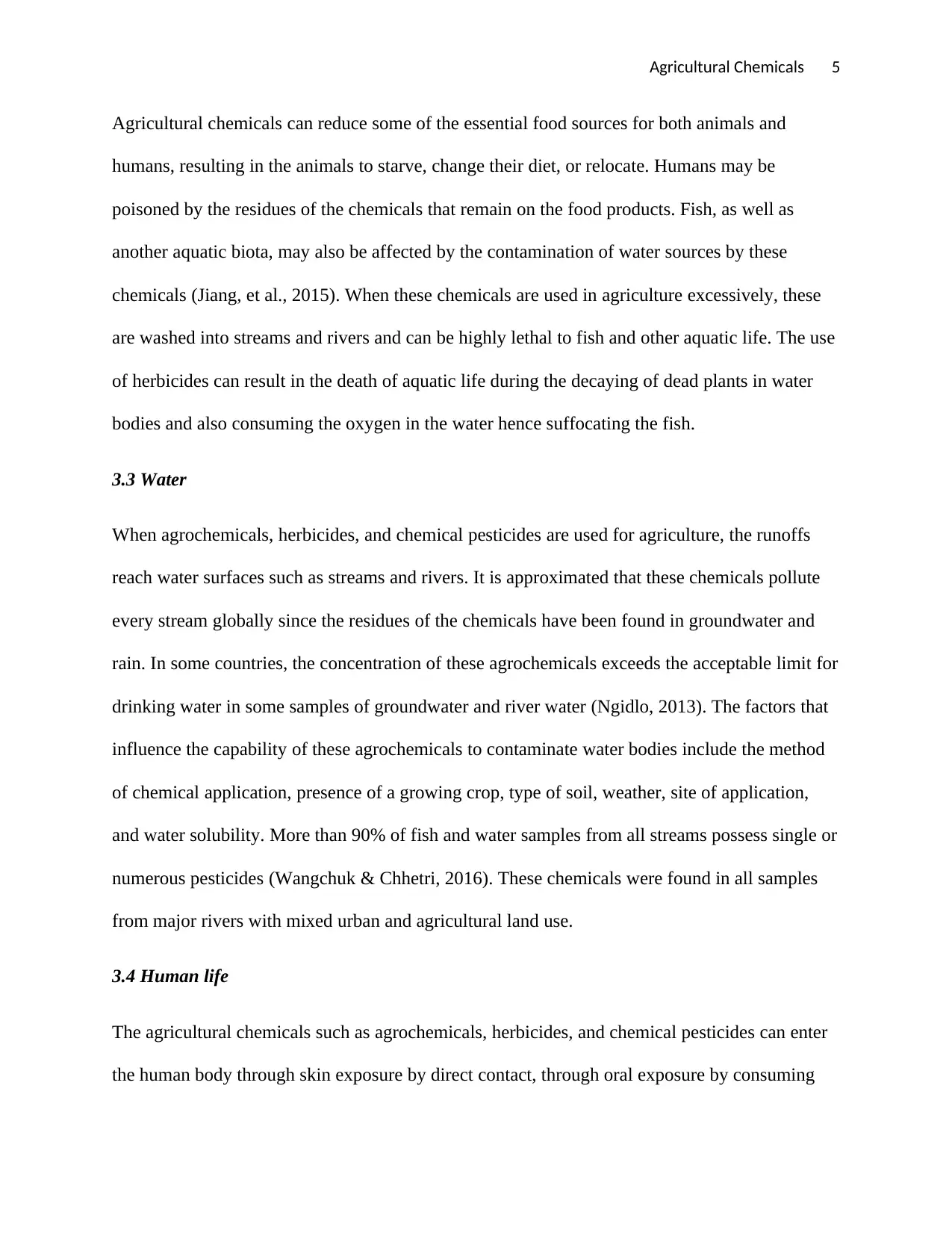
Agricultural Chemicals 5
Agricultural chemicals can reduce some of the essential food sources for both animals and
humans, resulting in the animals to starve, change their diet, or relocate. Humans may be
poisoned by the residues of the chemicals that remain on the food products. Fish, as well as
another aquatic biota, may also be affected by the contamination of water sources by these
chemicals (Jiang, et al., 2015). When these chemicals are used in agriculture excessively, these
are washed into streams and rivers and can be highly lethal to fish and other aquatic life. The use
of herbicides can result in the death of aquatic life during the decaying of dead plants in water
bodies and also consuming the oxygen in the water hence suffocating the fish.
3.3 Water
When agrochemicals, herbicides, and chemical pesticides are used for agriculture, the runoffs
reach water surfaces such as streams and rivers. It is approximated that these chemicals pollute
every stream globally since the residues of the chemicals have been found in groundwater and
rain. In some countries, the concentration of these agrochemicals exceeds the acceptable limit for
drinking water in some samples of groundwater and river water (Ngidlo, 2013). The factors that
influence the capability of these agrochemicals to contaminate water bodies include the method
of chemical application, presence of a growing crop, type of soil, weather, site of application,
and water solubility. More than 90% of fish and water samples from all streams possess single or
numerous pesticides (Wangchuk & Chhetri, 2016). These chemicals were found in all samples
from major rivers with mixed urban and agricultural land use.
3.4 Human life
The agricultural chemicals such as agrochemicals, herbicides, and chemical pesticides can enter
the human body through skin exposure by direct contact, through oral exposure by consuming
Agricultural chemicals can reduce some of the essential food sources for both animals and
humans, resulting in the animals to starve, change their diet, or relocate. Humans may be
poisoned by the residues of the chemicals that remain on the food products. Fish, as well as
another aquatic biota, may also be affected by the contamination of water sources by these
chemicals (Jiang, et al., 2015). When these chemicals are used in agriculture excessively, these
are washed into streams and rivers and can be highly lethal to fish and other aquatic life. The use
of herbicides can result in the death of aquatic life during the decaying of dead plants in water
bodies and also consuming the oxygen in the water hence suffocating the fish.
3.3 Water
When agrochemicals, herbicides, and chemical pesticides are used for agriculture, the runoffs
reach water surfaces such as streams and rivers. It is approximated that these chemicals pollute
every stream globally since the residues of the chemicals have been found in groundwater and
rain. In some countries, the concentration of these agrochemicals exceeds the acceptable limit for
drinking water in some samples of groundwater and river water (Ngidlo, 2013). The factors that
influence the capability of these agrochemicals to contaminate water bodies include the method
of chemical application, presence of a growing crop, type of soil, weather, site of application,
and water solubility. More than 90% of fish and water samples from all streams possess single or
numerous pesticides (Wangchuk & Chhetri, 2016). These chemicals were found in all samples
from major rivers with mixed urban and agricultural land use.
3.4 Human life
The agricultural chemicals such as agrochemicals, herbicides, and chemical pesticides can enter
the human body through skin exposure by direct contact, through oral exposure by consuming
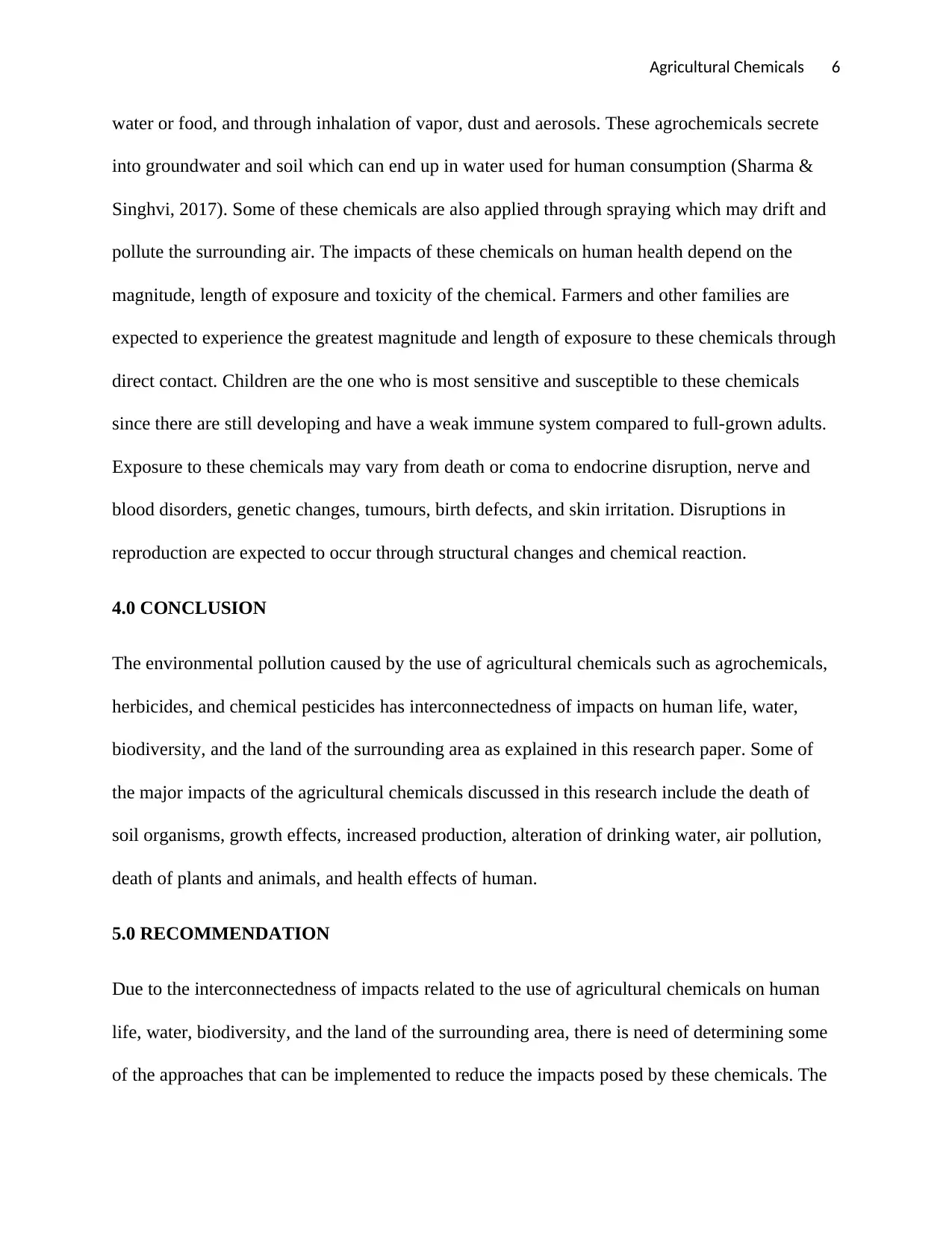
Agricultural Chemicals 6
water or food, and through inhalation of vapor, dust and aerosols. These agrochemicals secrete
into groundwater and soil which can end up in water used for human consumption (Sharma &
Singhvi, 2017). Some of these chemicals are also applied through spraying which may drift and
pollute the surrounding air. The impacts of these chemicals on human health depend on the
magnitude, length of exposure and toxicity of the chemical. Farmers and other families are
expected to experience the greatest magnitude and length of exposure to these chemicals through
direct contact. Children are the one who is most sensitive and susceptible to these chemicals
since there are still developing and have a weak immune system compared to full-grown adults.
Exposure to these chemicals may vary from death or coma to endocrine disruption, nerve and
blood disorders, genetic changes, tumours, birth defects, and skin irritation. Disruptions in
reproduction are expected to occur through structural changes and chemical reaction.
4.0 CONCLUSION
The environmental pollution caused by the use of agricultural chemicals such as agrochemicals,
herbicides, and chemical pesticides has interconnectedness of impacts on human life, water,
biodiversity, and the land of the surrounding area as explained in this research paper. Some of
the major impacts of the agricultural chemicals discussed in this research include the death of
soil organisms, growth effects, increased production, alteration of drinking water, air pollution,
death of plants and animals, and health effects of human.
5.0 RECOMMENDATION
Due to the interconnectedness of impacts related to the use of agricultural chemicals on human
life, water, biodiversity, and the land of the surrounding area, there is need of determining some
of the approaches that can be implemented to reduce the impacts posed by these chemicals. The
water or food, and through inhalation of vapor, dust and aerosols. These agrochemicals secrete
into groundwater and soil which can end up in water used for human consumption (Sharma &
Singhvi, 2017). Some of these chemicals are also applied through spraying which may drift and
pollute the surrounding air. The impacts of these chemicals on human health depend on the
magnitude, length of exposure and toxicity of the chemical. Farmers and other families are
expected to experience the greatest magnitude and length of exposure to these chemicals through
direct contact. Children are the one who is most sensitive and susceptible to these chemicals
since there are still developing and have a weak immune system compared to full-grown adults.
Exposure to these chemicals may vary from death or coma to endocrine disruption, nerve and
blood disorders, genetic changes, tumours, birth defects, and skin irritation. Disruptions in
reproduction are expected to occur through structural changes and chemical reaction.
4.0 CONCLUSION
The environmental pollution caused by the use of agricultural chemicals such as agrochemicals,
herbicides, and chemical pesticides has interconnectedness of impacts on human life, water,
biodiversity, and the land of the surrounding area as explained in this research paper. Some of
the major impacts of the agricultural chemicals discussed in this research include the death of
soil organisms, growth effects, increased production, alteration of drinking water, air pollution,
death of plants and animals, and health effects of human.
5.0 RECOMMENDATION
Due to the interconnectedness of impacts related to the use of agricultural chemicals on human
life, water, biodiversity, and the land of the surrounding area, there is need of determining some
of the approaches that can be implemented to reduce the impacts posed by these chemicals. The
⊘ This is a preview!⊘
Do you want full access?
Subscribe today to unlock all pages.

Trusted by 1+ million students worldwide

Agricultural Chemicals 7
use of pesticides should be replaced with biological pest control methods such as the use of
natural predators. Permaculture should also be embraced to assist farmers produce more food
using fewer resources.
use of pesticides should be replaced with biological pest control methods such as the use of
natural predators. Permaculture should also be embraced to assist farmers produce more food
using fewer resources.
Paraphrase This Document
Need a fresh take? Get an instant paraphrase of this document with our AI Paraphraser
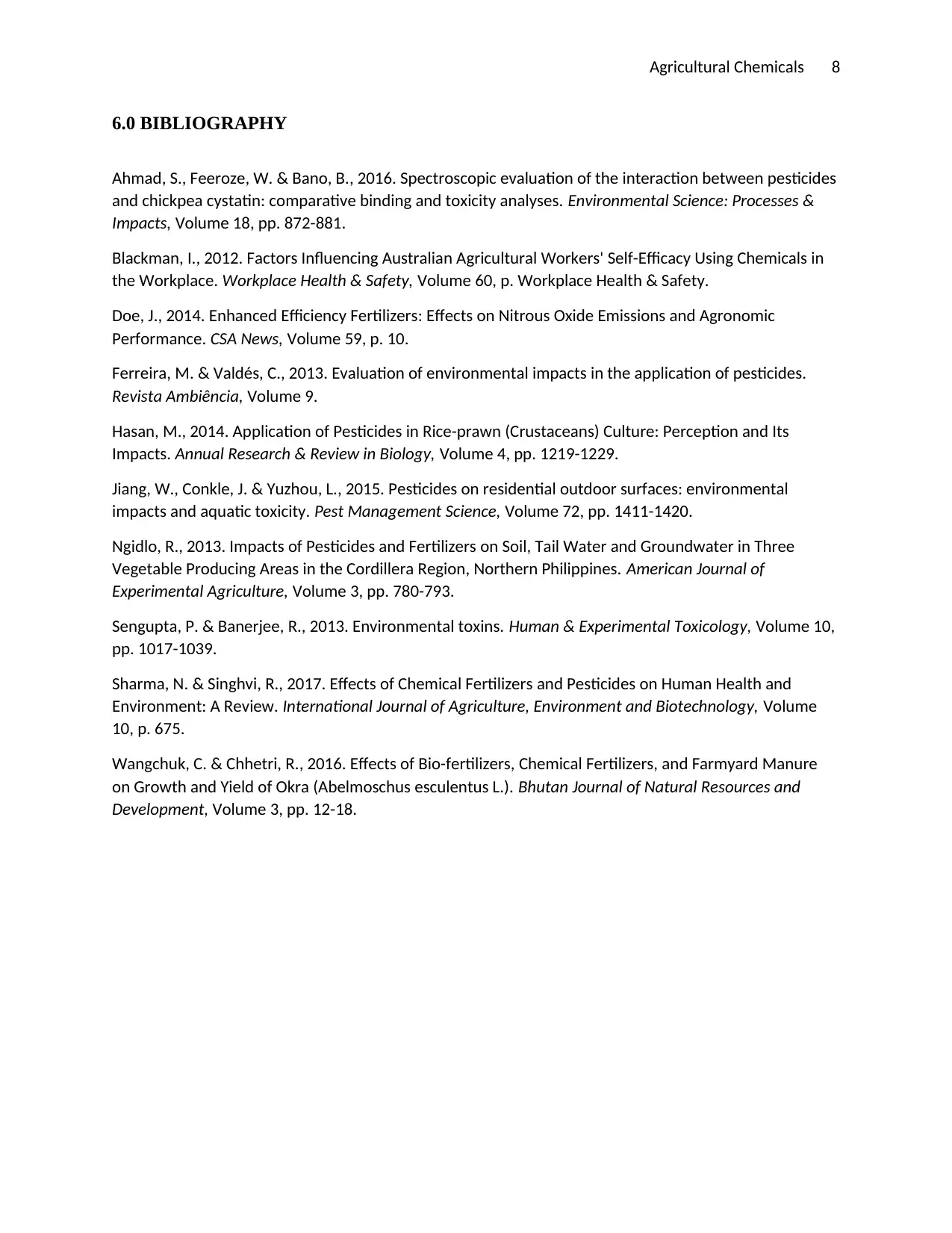
Agricultural Chemicals 8
6.0 BIBLIOGRAPHY
Ahmad, S., Feeroze, W. & Bano, B., 2016. Spectroscopic evaluation of the interaction between pesticides
and chickpea cystatin: comparative binding and toxicity analyses. Environmental Science: Processes &
Impacts, Volume 18, pp. 872-881.
Blackman, I., 2012. Factors Influencing Australian Agricultural Workers' Self-Efficacy Using Chemicals in
the Workplace. Workplace Health & Safety, Volume 60, p. Workplace Health & Safety.
Doe, J., 2014. Enhanced Efficiency Fertilizers: Effects on Nitrous Oxide Emissions and Agronomic
Performance. CSA News, Volume 59, p. 10.
Ferreira, M. & Valdés, C., 2013. Evaluation of environmental impacts in the application of pesticides.
Revista Ambiência, Volume 9.
Hasan, M., 2014. Application of Pesticides in Rice-prawn (Crustaceans) Culture: Perception and Its
Impacts. Annual Research & Review in Biology, Volume 4, pp. 1219-1229.
Jiang, W., Conkle, J. & Yuzhou, L., 2015. Pesticides on residential outdoor surfaces: environmental
impacts and aquatic toxicity. Pest Management Science, Volume 72, pp. 1411-1420.
Ngidlo, R., 2013. Impacts of Pesticides and Fertilizers on Soil, Tail Water and Groundwater in Three
Vegetable Producing Areas in the Cordillera Region, Northern Philippines. American Journal of
Experimental Agriculture, Volume 3, pp. 780-793.
Sengupta, P. & Banerjee, R., 2013. Environmental toxins. Human & Experimental Toxicology, Volume 10,
pp. 1017-1039.
Sharma, N. & Singhvi, R., 2017. Effects of Chemical Fertilizers and Pesticides on Human Health and
Environment: A Review. International Journal of Agriculture, Environment and Biotechnology, Volume
10, p. 675.
Wangchuk, C. & Chhetri, R., 2016. Effects of Bio-fertilizers, Chemical Fertilizers, and Farmyard Manure
on Growth and Yield of Okra (Abelmoschus esculentus L.). Bhutan Journal of Natural Resources and
Development, Volume 3, pp. 12-18.
6.0 BIBLIOGRAPHY
Ahmad, S., Feeroze, W. & Bano, B., 2016. Spectroscopic evaluation of the interaction between pesticides
and chickpea cystatin: comparative binding and toxicity analyses. Environmental Science: Processes &
Impacts, Volume 18, pp. 872-881.
Blackman, I., 2012. Factors Influencing Australian Agricultural Workers' Self-Efficacy Using Chemicals in
the Workplace. Workplace Health & Safety, Volume 60, p. Workplace Health & Safety.
Doe, J., 2014. Enhanced Efficiency Fertilizers: Effects on Nitrous Oxide Emissions and Agronomic
Performance. CSA News, Volume 59, p. 10.
Ferreira, M. & Valdés, C., 2013. Evaluation of environmental impacts in the application of pesticides.
Revista Ambiência, Volume 9.
Hasan, M., 2014. Application of Pesticides in Rice-prawn (Crustaceans) Culture: Perception and Its
Impacts. Annual Research & Review in Biology, Volume 4, pp. 1219-1229.
Jiang, W., Conkle, J. & Yuzhou, L., 2015. Pesticides on residential outdoor surfaces: environmental
impacts and aquatic toxicity. Pest Management Science, Volume 72, pp. 1411-1420.
Ngidlo, R., 2013. Impacts of Pesticides and Fertilizers on Soil, Tail Water and Groundwater in Three
Vegetable Producing Areas in the Cordillera Region, Northern Philippines. American Journal of
Experimental Agriculture, Volume 3, pp. 780-793.
Sengupta, P. & Banerjee, R., 2013. Environmental toxins. Human & Experimental Toxicology, Volume 10,
pp. 1017-1039.
Sharma, N. & Singhvi, R., 2017. Effects of Chemical Fertilizers and Pesticides on Human Health and
Environment: A Review. International Journal of Agriculture, Environment and Biotechnology, Volume
10, p. 675.
Wangchuk, C. & Chhetri, R., 2016. Effects of Bio-fertilizers, Chemical Fertilizers, and Farmyard Manure
on Growth and Yield of Okra (Abelmoschus esculentus L.). Bhutan Journal of Natural Resources and
Development, Volume 3, pp. 12-18.
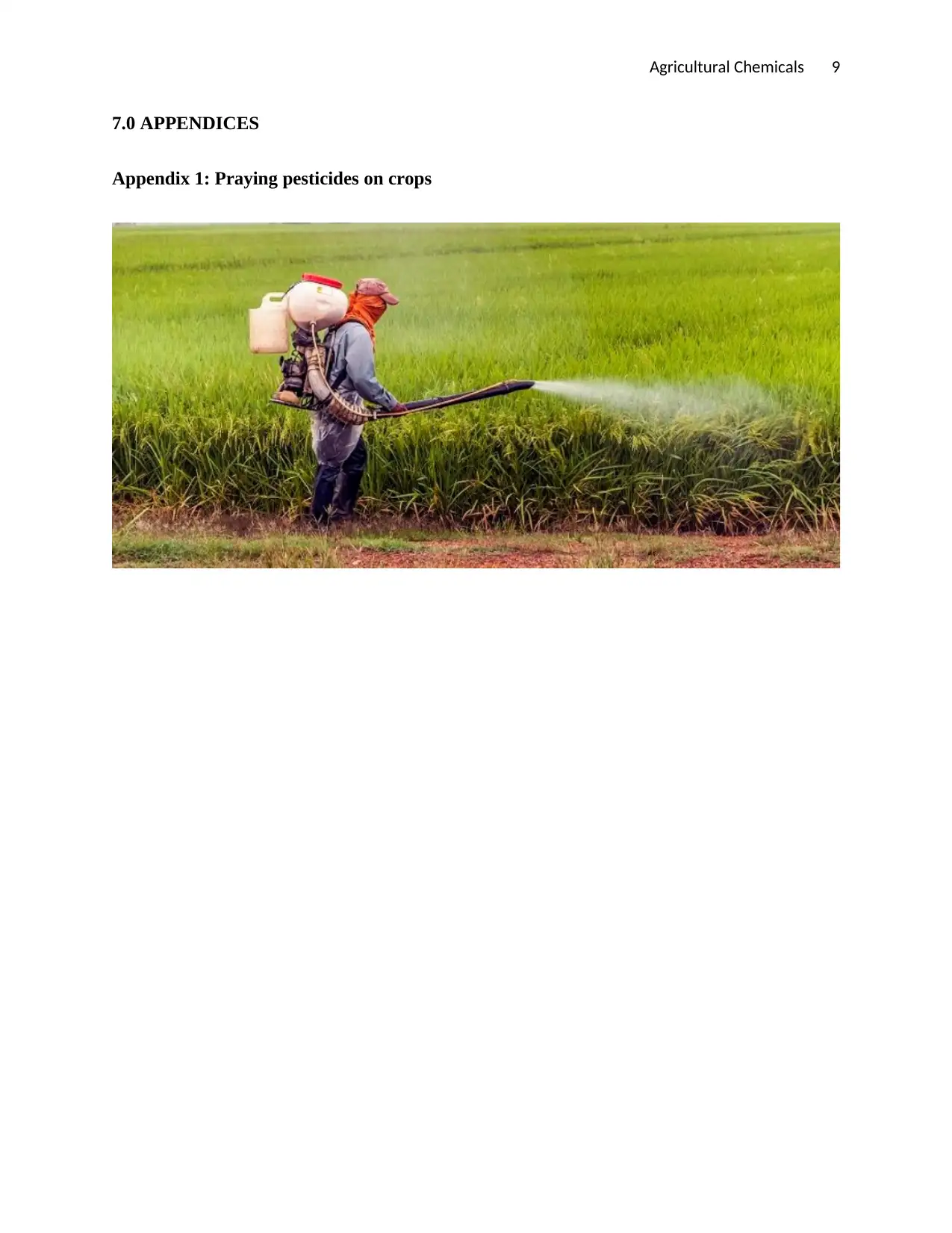
Agricultural Chemicals 9
7.0 APPENDICES
Appendix 1: Praying pesticides on crops
7.0 APPENDICES
Appendix 1: Praying pesticides on crops
⊘ This is a preview!⊘
Do you want full access?
Subscribe today to unlock all pages.

Trusted by 1+ million students worldwide
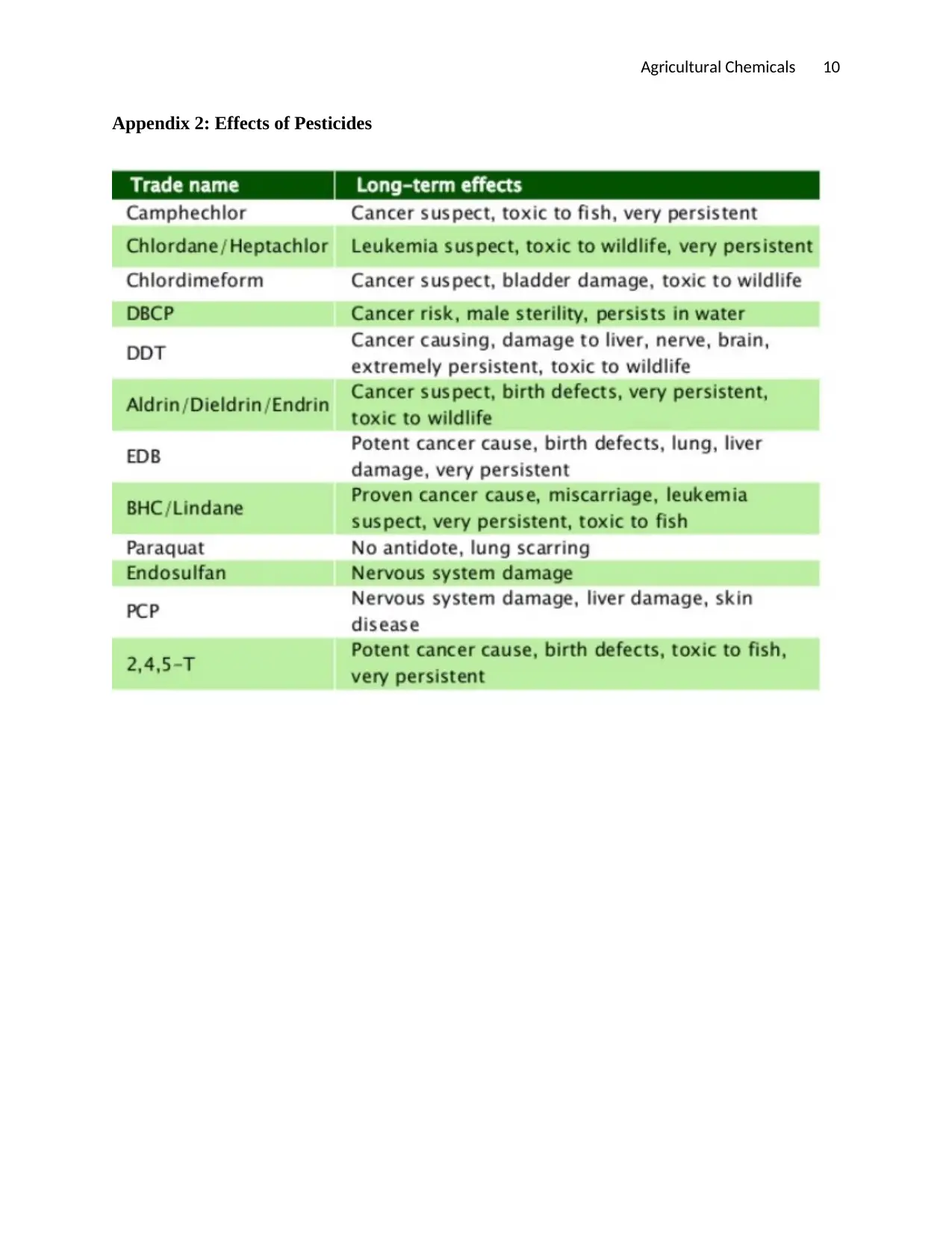
Agricultural Chemicals 10
Appendix 2: Effects of Pesticides
Appendix 2: Effects of Pesticides
1 out of 10
Your All-in-One AI-Powered Toolkit for Academic Success.
+13062052269
info@desklib.com
Available 24*7 on WhatsApp / Email
![[object Object]](/_next/static/media/star-bottom.7253800d.svg)
Unlock your academic potential
Copyright © 2020–2025 A2Z Services. All Rights Reserved. Developed and managed by ZUCOL.